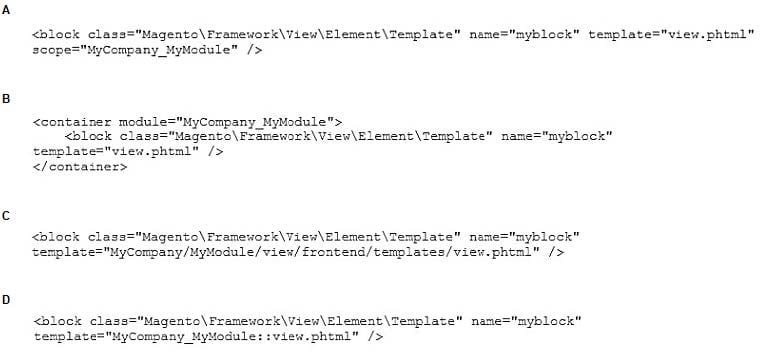AD0-E703 Online Practice Questions and Answers
A third-party module uses a layout update that changes the template path for a core block from product/ view/addto/compare.phtml of the Magento_Catalog module to custom/view/addto/compare.phtml of your custom module. The merchant has a customized version of this template in their custom theme.
What is a consequence of this setup?
A. If the custom module is removed, the custom template will no longer apply
B. This setup will throw an IllegalStateException
C. If a preference for the core block is set, the template will no longer apply
D. If another module is installed which also customizes the same core template, the templates will be rendered sequentially
Which two ways does Magento persist category relationships in the database? (Choose two.)
A. Using slash-separated values in the path field
B. in the table catalog_category_index
C. in the parent_id field
D. Using comma-separated values in the parent-ids field
A merchant is interested in setting different prices for the same products in different store scopes.
What do you reply to this inquiry?
A. The prices can only be scoped per website or globally
B. The prices can be scoped per store
C. The price scope can be set to store but this will lead to performance degradation of category pages
D. The prices do not support scopes
You have created a module with a custom ACL resource and want to restrict access to resources of your module.
Which three items are restricted based on ACL role permissions? (Choose three.)
A. CLI Commands
B. Webapi resources
C. Storefront login
D. System configuration sections
E. Adminhtml controllers
The module MyCompany_MyModule will add a new page in the admin interface to display a custom entity in a grid.
You created a controller for this grid \MyCompany\MyModule\Controller\Adminhtml\CustomEntity\Index
Which two actions are required to make the new page accessible at the https://your.store.base.url/admin/ my_module/custom_entity URL? (Choose two.)
A. Register my_module route for the AdminRouter in MyCompany/MyModule/etc/adminhtml/di.xml
B. Create a new menu item in MyCompany/MyModule/etc/adminhtml/menu.xml
C. Specify the my_module/custom_entity URL using a @route annotation in the action controller execute() method
D. Register my_module route in MyCompany/MyModule/etc/adminhtml/routes.xml
Magento and third-party developers can find it difficult to track and report the dependencies that customized extensions have on other extensions. To address these issues, the Magento system introduces service contracts. What is a Service Contracts - Data interfaces?
A. set of PHP interfaces that are defined for a module includes data interfaces
B. set of API interfaces that are defined for a module includes web APIs
C. set of UI Library that are defined for a module includes ui content
D. set of JS Library that are defined for a module includes js Library
You have been given the task of importing products from an external source. You decide to create a custom module to do this. The class handling the import creates a product for each record, sets the data on it and saves it to the database.
What do you inject into a constructor to represent each product you create?
A. \Magento\Catalog\Model\Product
B. \Magento\Catalog\Api\Data\ProductInterfaceFactory
C. \Magento\Catalog\Api\Data\ProductInterface
D. \Magento\Catalog\Model\ProductBuilder
You want to declare a block of the type \Magento\Framework\View\Element\Template with a template named view.phtml in the layout XML.
What is the correct layout declaration for this?

A. Option A
B. Option B
C. Option C
D. Option D
